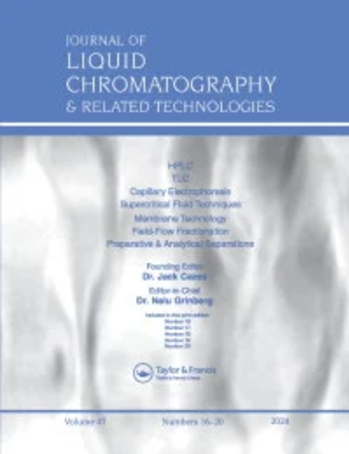逆流色谱:分离原理、机械设计、发展趋势及应用
IF 1.2
4区 化学
Q4 BIOCHEMICAL RESEARCH METHODS
Journal of Liquid Chromatography & Related Technologies
Pub Date : 2022-05-09
DOI:10.1080/10826076.2022.2117190
引用次数: 0
摘要
摘要:逆流色谱法(CCC)是一种基于两种不混相溶剂对样品的不同分配系数的分离技术,是一种柱内无固体支撑的液-液分配。本文首先阐述了CCC的力学平衡原理,包括流体静力平衡系统(HSES)、流体动力平衡系统(HDES)、单向流体动力平衡现象等;说明了CCC的分离原理。其次,分别阐述了平行轴、交叉轴、斜轴三种同轴电机的机械结构和设计,以及由这三种电机衍生出来的一些同轴电机。最后,揭示了CCC发展中存在的问题,并对CCC未来的发展方向和应用趋势进行了探讨。图形抽象本文章由计算机程序翻译,如有差异,请以英文原文为准。
Countercurrent chromatography: separation principle, mechanical design, development trends, and applications
Abstract Countercurrent chromatography (CCC) is the separation technique based on the different partition coefficients of the sample between two immiscible solvents, which is a liquid-liquid partition without solid support in the column. In this paper, Firstly, the mechanic’s equilibrium principle of CCC is described, which includes hydrostatic equilibrium system (HSES), hydrodynamic equilibrium system (HDES), unidirectional hydrodynamic equilibrium phenomenon, etc. The separation principle of the CCC is also explained. Secondly, the mechanical structure and design of parallel-axis CCC, cross-axis CCC, oblique-axis CCC, as well as some CCC derived from the three are illustrated respectively. Finally, the existing problems for the development of CCC have been exposed, and the trend of the future development direction and applications of CCC are discussed. Graphical Abstract
求助全文
通过发布文献求助,成功后即可免费获取论文全文。
去求助
来源期刊
CiteScore
2.80
自引率
0.00%
发文量
29
审稿时长
4.9 months
期刊介绍:
The Journal of Liquid Chromatography & Related Technologies is an internationally acclaimed forum for fast publication of critical, peer reviewed manuscripts dealing with analytical, preparative and process scale liquid chromatography and all of its related technologies, including TLC, capillary electrophoresis, capillary electrochromatography, supercritical fluid chromatography and extraction, field-flow technologies, affinity, and much more. New separation methodologies are added when they are developed. Papers dealing with research and development results, as well as critical reviews of important technologies, are published in the Journal.

 求助内容:
求助内容: 应助结果提醒方式:
应助结果提醒方式:


